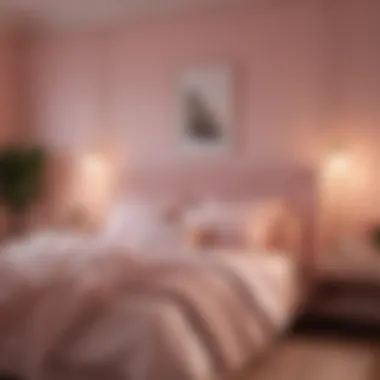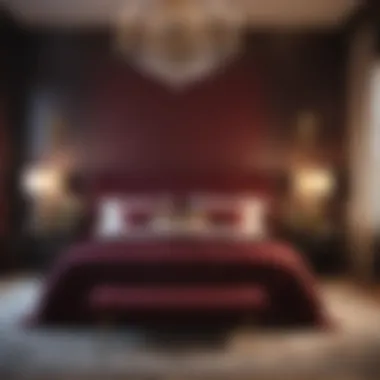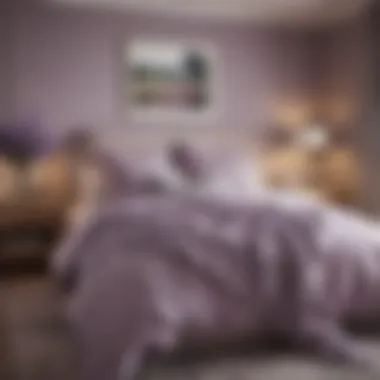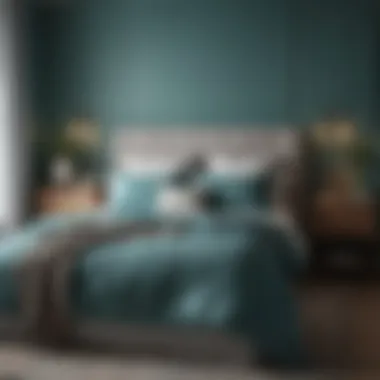Romantic Colors for a Serene Master Bedroom


Intro
Creating a master bedroom that resonates with romance is more than just choosing a bedspread or window treatments. It involves an analysis of colors, their emotional impacts, and their ability to transform spaces. The right colors can evoke feelings of love, tranquility, and closeness. This article delves into the concept of romantic colors for bedrooms, providing an understanding of how these hues influence moods and interactions.
The exploration begins with design inspiration, examining trending styles and color palettes known for their romantic qualities. Following this, practical tips will guide the reader on how to integrate these colors into their space effectively. From maintaining the desired aesthetic to budgeting for a makeover, this article aims to furnish homeowners and design enthusiasts alike with the knowledge to create a loving environment in their master bedroom.
By weaving together color psychology with practical advice, we bring forth a comprehensive guide. The ultimate goal is to help you cultivate an atmosphere that fosters intimacy and serenity.
Understanding Romantic Colors
Colors in master bedrooms significantly impact emotional well-being and relationship dynamics. The choice of color goes beyond mere aesthetics. It plays a crucial role in creating a serene and inviting atmosphere that fosters intimacy. Understanding romantic colors involves recognizing how different hues can evoke feelings of love, peace, and comfort.
One benefit of selecting the right romantic colors is their ability to influence mood. Colors can calm the mind or stimulate the senses, transforming a space into a personal retreat. Moreover, the consideration of color in bedroom design encourages homeowners to reflect on how their environment shapes emotional experiences.
It is essential to recognize that romantic colors need not be limited to traditional reds or pinks. A broader spectrum of hues can create various romantic vibes. These can include soft pastels that invoke tranquility or deep jewel tones that enhance sophistication. The emotional resonance of specific colors should be examined with personal experience in mind. This understanding helps in achieving a bedroom design that genuinely reflects individual tastes and preferences.
The Psychology of Color
Color psychology provides insight into how colors affect human emotions and behaviors. It shows that each color can invoke a unique emotional response. For instance, warm colors such as red and orange tend to stimulate energy and passion. In contrast, cool colors such as blue and green often promote calmness and relaxation.
Studies indicate that bedrooms painted in specific shades can affect sleep quality and overall mood. Soft blues and greens can lower anxiety while promoting restfulness. On the other hand, hues like mauve or lavender create a romantic yet soothing environment that enhances intimacy. Thus, the deliberate selection of colors can impact relational dynamics.
Mood Enhancement Through Color Choice
Choosing the appropriate color scheme can significantly uplift the mood in a master bedroom. It can help create a peaceful environment that nurtures relaxation and romantic connections. Colors can influence the perception of space, making it feel larger or cozier, enhancing one's overall experience within the room.
Here are some crucial considerations for mood enhancement through color:
- Light Colors: Light shades tend to create airiness in a room, which can promote feelings of open space.
- Warm Tones: Warm colors enhance energy and invite warmth into relationships.
- Cool Shades: These tones typically encourage tranquility and restfulness.
- Accent Colors: Using bold colors in accents can highlight particular areas and enhance overall aesthetics without overwhelming the space.
Choosing the colors thoughtfully ensures the master bedroom serves its primary purpose as a haven for relaxation and romance. The interplay of colors can elevate simple moments into cherished experiences.
Popular Romantic Color Palettes
In the quest to create a master bedroom that exudes romance and serenity, understanding popular romantic color palettes is essential. The colors you choose set the tone for the space; they influence mood, comfort, and intimacy. Selecting the right palette can transform an ordinary room into a sanctuary, fostering a deep connection between those who inhabit it. Here, we will delve into three popular palettes: Soft Neutrals, Blush and Rose Tones, and Deep Jewel Tones. Each palette carries unique benefits and elements that can harmonize with various design preferences.
Soft Neutrals
Soft neutrals, comprising shades like beige, taupe, and gentle grays, offer a timeless appeal. These colors promote a sense of calm and sophistication in a master bedroom. Soft neutrals create an inviting backdrop that pairs well with both bold accents and delicate decor.
When using soft neutrals, consider the following:
- Versatility: These colors work with a variety of decor styles, from modern to traditional.
- Light Reflection: Neutrals can enhance natural light, making a room feel more spacious.
- Complementary Options: They easily blend with saturated hues, allowing for creative accents without overwhelming the space.
By utilizing soft neutral tones, homeowners can develop a warming and intimate environment conducive to relaxation and romantic moments.
Blush and Rose Tones
Blush and rose tones are inherently soft and soothing. These colors infuse a sense of warmth and tenderness into the bedroom. They not only evoke romance but also elicit feelings of affection and tenderness. Shades like peach, dusty pink, and soft coral create inviting spaces that nurture connections.
Consider the charm of blush and rose tones:
- Emotional Warmth: These colors can make the space feel nurturing and loving.
- Subtle Elegance: Unlike brighter colors, blush tones manage to be statement-making without being overpowering.
- Adaptive: They pair wonderfully with both light and dark accent colors, making them extremely adaptable in design.
Incorporating blush and rose tones can offer a harmonious atmosphere that enhances personal interactions within the master bedroom.
Deep Jewel Tones
Deep jewel tones such as emerald green, sapphire blue, and amethyst purple bring richness and impact to a romantic master bedroom. These colors create depth and drama, doing well in settings where intimacy and warmth are paramount. Deep jewel tones not only signify luxury but also instill a sense of comfort and security.


Benefits of using deep jewel tones include:
- Visual Interest: They attract the eye and can become focal points when used strategically.
- Mood Enhancement: Darker shades often create a cozy feeling, ideal for evening relaxation.
- Contrast Opportunities: Jewel tones can be paired with metallic accents, enhancing their luxurious feel.
These tones work exceptionally well in larger spaces where they can envelop a room in visual richness without feeling claustrophobic.
In summary, selecting appropriate colors for a master bedroom is crucial in establishing a romantic atmosphere. Soft neutrals offer tranquility, blush and rose tones express warmth, while deep jewel tones provide richness. Each palette brings distinct character and possibilities. This understanding will assist homeowners and design enthusiasts in making informed choices that enhance not just the aesthetic but also the emotional essence of their space.
Choosing the Right Shade
Selecting the right shade for your master bedroom is crucial. Colors significantly influence the atmosphere of a space. They can evoke feelings of calmness, warmth, or even intimacy. Therefore, understanding how to choose shades is a fundamental aspect of interior design.
When determining the right shade, consider a few essential elements. These include the size of your room, the amount of natural light it receives, and your personal preferences. Each factor plays a role in how colors interact with the space. A thoughtful color choice can enhance the aesthetic appeal and emotional ambiance of the bedroom.
The benefits of choosing the right shade are numerous. For instance, lighter shades can make a small room appear more spacious. Darker hues add a level of coziness, making the space feel more intimate. Moreover, the correct shade can create a serene environment that encourages relaxation and romance. Understanding the dynamics at play helps in making better and more effective color selections, tailored to your unique living space.
Consider the Room Size
Room size is a key consideration when choosing colors. In smaller rooms, light colors such as soft whites or pastel tones can create an illusion of more space. They reflect natural light, making the room feel airy and expansive. On the other hand, larger rooms are more flexible with color options. For these spaces, deeper colors can introduce warmth and a sense of closeness.
Things to consider for room size:
- Smaller Rooms: Use airy light shades. This creates an open feel without overwhelming the senses.
- Medium Rooms: A balance of light and mid-tone shades can work well. Introduce color through accent walls or decor.
- Larger Rooms: Here, you can explore deeper jewel tones or bolder colors to add richness and visual interest.
Evaluating Natural Light
Natural light plays a significant role in how color is perceived within a room. Different light sources—like daylight, evening light, or artificial lighting—can alter the appearance of a hue dramatically. It’s important to observe how light interacts with your chosen shades throughout the day.
- In south-facing rooms, colors will have a warm glow during the day, making rich hues more appealing.
- North-facing rooms receive cooler light, which often makes colors appear more muted. Warmer tones can bring vibrancy back into these spaces.
Key considerations for evaluating natural light:
- Time of Day: Observe your room at different times to see how natural light changes the color.
- Window Orientation: Take note of how much sun exposure your bedroom receives.
- Artificial Lighting: Don’t forget to check how your selected hues appear under artificial light during evenings.
A clear understanding of how natural light influences color can lead to more effective shading decisions in your bedroom.
Assessing Personal Preferences
Personal preferences should be at the forefront when choosing shades for your bedroom. Each individual has unique tastes that inform their comfort and emotional connection to a space. By reflecting on what colors appeal to you, you can achieve a bedroom that feels like a true sanctuary.
- Consider your favorite colors. Think about how these can be blended into the decor while maintaining a romantic atmosphere.
- Also, reflect on your emotional responses to different colors. Certain shades can make you feel calm, energized, or even nostalgic. These emotional connections can contribute to the overall mood of the bedroom.
Questions to consider for assessing personal preferences:
- What colors do you feel drawn to?
- How do certain colors make you feel in various contexts?
- Are there color schemes associated with fond memories or experiences?
Ultimately, weaving personal preference into the color selection will result in a bedroom that resonates deeply with you and fosters a lasting sense of romance.
Combining Colors Effectively
The process of combining colors effectively is essential in achieving the desired atmosphere in a master bedroom. Color sets the mood, influences emotions, and can create intimacy. To harness the full potential of color combinations, one must understand how they interact with each other. By applying thoughtful consideration to color pairing, homeowners can craft a serene and inviting space.
Color Wheel Basics
Understanding the color wheel is crucial for effective color combinations. The color wheel arranges primary, secondary, and tertiary colors in a circular format, showcasing their relationships.
- Primary Colors: Red, Blue, Yellow
- Secondary Colors: Green, Orange, Purple (formed by mixing primary colors)
- Tertiary Colors: Combinations of primary and secondary colors
When combining colors, consider choosing from:


- Analogous Colors: These are colors that reside next to each other on the wheel, such as blue, blue-green, and green. They create a harmonious look.
- Complementary Colors: Found opposite each other on the wheel, like blue and orange. These create a striking contrast that is appealing.
- Triadic Colors: Three colors evenly spaced on the wheel provide balance and vibrancy when used.
Understanding these basics enables homeowners to make informed decisions on the palette they wish to implement in their bedrooms.
Accent Colors and Their Impact
Accent colors play a pivotal role in the overall design. They add depth and interest, drawing the eye and creating focal points in the room. When selecting accents, small doses can effectively enhance the primary colors of the room. Here are some considerations:
- Control the Quantity: Use accent colors in moderation, such as in throw pillows, artworks, or decorative items, to prevent overwhelming the space.
- Choose Wisely: Aim for colors that complement the primary palette. For instance, if the primary color is soft gray, a deeper shade like charcoal can serve well as a rich accent.
- Consider Textures: Different materials can influence how colors are perceived. Mixing materials like silk and cotton can add richness and vitality.
The right accent colors can create a layered look, encouraging a warm and inviting ambiance.
Creating Contrast
Effective contrast is vital in bringing excitement and interest to a bedroom. It prevents the space from feeling flat and monotonous. There are several strategies to implement contrast:
- Light vs. Dark: Pairing light colors with dark shades enhances visual interest. For example, pale blush walls can be offset with dark wood furniture.
- Warm vs. Cool: Combining warm colors like reds and oranges with cool blues and greens can create a dynamic balance that is both refreshing and cozy.
- Texture and Patterns: Contrasting textures and patterns can enrich the visual experience. A smooth satin pillow against a textured woven throw creates depth and intrigue.
In summary, combining colors effectively requires a deep understanding of color theory and personal taste. By leveraging the color wheel, selecting appropriate accents, and focusing on contrast, homeowners can establish a romantic and tranquil bedroom that reflects their style and enhances their mood.
"Colors can transform a room, creating an atmosphere that encourages relaxation and intimacy. Selecting the right combinations can make all the difference in achieving that goal."
Engaging in this thoughtful process is integral for cultivating the ideal romantic environment.
Textiles and Decor Considerations
When creating a romantic atmosphere in the master bedroom, textiles and decor play a crucial role. The right selection can transform a space, adding warmth and intimacy. Textiles not only contribute to a room's aesthetic but also affect tactile sensations, which can enhance emotional connections in the space. Decor elements reinforce the overall theme and create focal points, directing the eye in harmonizing ways.
Selecting Bedding and Fabrics
Bedding and fabric choices are foundational to any bedroom's appearance. Textures, colors, and patterns can greatly influence mood and comfort. For romantic settings, consider materials like soft cotton, silky satin, or plush velvet. These fabrics not only feel luxurious but also invite relaxation.
- Color Choices: Lighter hues like cream or pale pink evoke softness, while deeper shades like burgundy add richness.
- Patterns: Floral or abstract designs can enhance the romantic vibes, especially when paired well with other elements in the room.
- Layering: Incorporating layers through throw pillows and blankets creates dimension and comfort.
Proper bedding selection is essential for not only looks but also for sleep quality, impacting overall mood.
Incorporating Artwork and Accents
Artwork and small accents deepen the romantic feel of a master bedroom. Carefully chosen pieces can highlight colors and themes in a subtle way.
- Personal Art: Family photos or memories can add a sentimental touch.
- Color Coordination: Art pieces should resonate with the chosen color palette. For example, a painting with soft pastels can complement blush-toned walls beautifully.
- Accents: Items such as candles, vases, or decorative trays can enhance ambiance. They bring personal taste into play while contributing to the overall romantic theme.
Consistent theme throughout the room ties all elements together, creating a peaceful retreat that encourages relaxation.
Lighting and Its Role in Color Perception
Lighting is often underestimated but is vital in establishing the overall mood of a bedroom. It influences how colors are perceived and can enhance the ambiance dramatically.
- Natural Light: Make use of daylight where possible. It seems softer and more romantic. Open curtains during the day and embrace the natural glow.
- Artificial Lighting: Use lamps with dimmers to adjust brightness as needed. Warm-toned bulbs create inviting scenarios compared to harsh white lights.
- Layered Lighting: Incorporate different light sources including table lamps, overhead fixtures, and candles. This method provides flexibility and depth to the space.
Remember, the right lighting can turn cold shades warm and elevate a relaxed environment to one that feels intimately connected.
Practical Applications
Understanding the practical applications of color in the master bedroom is crucial for creating a romantic environment. The right color scheme not only enhances aesthetics but also contributes significantly to emotional well-being. Applying these concepts can result in a personalized space that fosters relaxation, intimacy, and romance. Homeowners, designers, and anyone interested in enhancing their personal space should consider the practical implications of their color choices.
Incorporating romantic colors in the master bedroom can lead to numerous benefits:
- Mood Regulation: Colors greatly influence emotions. For instance, soft blues can induce calmness while warm reds might elevate passion. Choosing the right mix can help set the desired ambiance.
- Visual Cohesion: Creating a harmonious look in the bedroom ensures that every element complements one another. This nuanced approach to color goes beyond mere aesthetics; it functions to unify different decor elements.
- Customizable Elements: A thoughtful color palette allows for easy modifications. Changing mood or design can be as simple as uplifting accessories or textiles, without the need for major renovations.


These elements should be at the forefront of anyone’s mind when thinking of romantic colors for a master bedroom.
Case Studies of Romantic Bedrooms
Analyzing real-life examples can provide valuable insights into how color choices impact the feel of a master bedroom. Successful case studies often showcase various styles, from minimalist to opulent.
- Modern Minimalist: A couple redesigned their bedroom using muted shades of gray and cream, combined with blush accents. The simplicity of colors created an uncluttered, soothing environment conducive to relaxation.
- Eclectic Joy: Another couple opted for deep jewel tones—emerald green and royal blue. They added golden accents, making the space feel luxurious and inviting. This color combination elevated their space without overwhelming the senses.
- Bohemian Charm: Utilizing terra cotta, muted lavender, and soft beachy hues in an airy space, one homeowner highlighted a breezy yet romantic atmosphere. Natural light accentuated these colors beautifully, creating a vibrant yet tranquil vibe.
These case studies demonstrate the wide-ranging applications of romantic colors, emphasizing how diverse approaches can successfully transform a bedroom.
DIY Projects for a Romantic Touch
Engaging in DIY projects is a practical way to add personal flair, ensuring that each element reflects individual style and taste. Here are some project ideas to consider:
- Hand-Painted Accent Wall: A feature wall painted in a romantic hue can serve as the focal point of the room. Consider a slow-gradient effect from a soft blush to deeper rose for added depth.
- Customized Bed Linen: Take plain white bedding and dye it with colors matching your scheme. Using natural dyes can create soft, blended colors that evoke a gentle ambiance.
- Personalized Artwork: Create or select artwork incorporating your chosen colors. Framing prints or paintings that resonate emotionally can enhance overall aesthetics and foster a cozy environment.
- Mood Lighting: Install dimmable LED strip lights around the bed frame or incorporate colored lanterns. This simple addition allows for easy mood adjustments, enhancing the romantic atmosphere.
Engaging in these projects allows homeowners to infuse their unique personality into their space while embracing the romantic nature of color.
Maintaining a Romantic Atmosphere
Creating a romantic atmosphere in a master bedroom is essential for fostering intimacy and emotional connection. This section delves into the nuances that contribute to such an ambiance, highlighting the importance of color, texture, sound, and scent.
When it comes to romance, the atmosphere sets the stage for connection. Soft colors, cozy fabrics, and thoughtful decorations all play roles in achieving this ambiance. Elements such as ambient lighting and curated scents can enhance feelings of warmth and love. Each layer adds depth, transforming a mere bedroom into a peaceful sanctuary that encourages relaxation and closeness.
Seasonal Color Adjustments
Adjusting colors according to seasonal changes can keep the bedroom feeling fresh and maintain an inviting aura. For example, lighter shades can be emphasized in warmer months, creating a cool and airy feel. For autumn and winter, deeper shades, like burgundy or navy, can contribute to a more cozy and intimate setting.
Furthermore, embracing seasonal motifs can lead to a more harmonious environment. Here are some ideas for implementing seasonal adjustments:
- Spring: Consider pastels such as soft greens and pale pinks to evoke a sense of renewal.
- Summer: Bright hues or tropical colors can provide vibrance.
- Autumn: Warm earth tones create a rich, welcoming atmosphere.
- Winter: Wear darker shades and layer with plush materials to invoke warmth.
"Seasonal adjustments can rejuvenate the space, keeping the romantic tone alive year-round."
In addition to color, integrating seasonal decor can lighten or deepen the mood, which is crucial for keeping the romantic atmosphere lively and engaging.
Incorporating Scent and Sound
Sensory details play a vital role in maintaining a romantic atmosphere. Scent can evoke memories and feelings that enhance love and intimacy. Fragrances like jasmine, sandalwood, and vanilla are popular choices that create a soothing backdrop.
Here are a few ways to integrate scent into the bedroom:
- Scented Candles: They provide warmth and a soft glow, perfect for setting a romantic scene.
- Essential Oil Diffusers: These offer a range of customized aromatic experiences.
- Fresh Flowers: A vase with seasonal blooms can be visually pleasing and fragrant.
Sound can also uplift the ambiance. Softer music or nature sounds can help create a calming environment. Use speakers or gentle sound machines to cultivate a tranquil atmosphere that encourages relaxation and closeness. Consider the following options:
- Soft Instrumentals: Choose music that promotes calm, setting a gentle mood.
- Nature Sounds: Incorporate sounds like rain or ocean waves for peaceful backdrops.
- Customized Playlists: Curate a selection of songs that are meaningful to your relationship.
Combining scent and sound complements the visual aspects of a bedroom, making it a holistic space for romance. Keeping the atmosphere fresh and alive through these detailed sensory considerations is vital to maintaining a romantic environment.
Ending
Understanding the impact of color in the master bedroom is essential for creating a romantic atmosphere. This article highlights how the choice of colors can transform a space into a retreat that fosters intimacy and comfort.
Reflection on Color's Impact
Color Psychology plays a significant role in how we perceive and respond to our environments. Specific colors evoke certain emotions and can influence our moods. For a romantic bedroom, softer shades like pale pink or creamy beige can promote tranquility and closeness.
When reflecting on the importance of colors in a master bedroom, consider the following elements:
- Emotional Response: Colors like deep red can stimulate passion but may also overwhelm in large doses. Balancing bolder colors with softer tones creates harmony.
- Serenity and Relaxation: Cool colors such as lavender and light blue can enhance relaxation, making them ideal for promoting restful sleep and intimate moments.
- Personal Connection: Individual preferences play a crucial part. A couple might find certain shades remind them of shared experiences. This connection can deepen their emotional ties.
"The right colors can elevate a space from ordinary to extraordinary, impacting one's mood and experience daily."
By carefully selecting colors based on psychology and emotional triggers, homeowners can intentionally craft a sanctuary that reflects their romantic aspirations.
Furthermore, considering natural light, room size, and personal preference elevates the design process. Thus, the correct color palette becomes a critical tool in enhancing the overall aesthetic and emotional resonance of the master bedroom.















